UNIT 3
Memory Management and Deadlock
Introduction to Deadlock:
Every process needs some resources to complete its execution. However, the resource is granted in a sequential order.
A Deadlock is a situation where each of the computer process waits for a resource which is being assigned to some another process. In this situation, none of the process gets executed since the resource it needs, is held by some other process which is also waiting for some other resource to be released.
Let us assume that there are three processes P1, P2 and P3. There are three different resources R1, R2 and R3. R1 is assigned to P1, R2 is assigned to P2 and R3 is assigned to P3.
After some time, P1 demands for R1 which is being used by P2. P1 halts its execution since it can't complete without R2. P2 also demands for R3 which is being used by P3. P2 also stops its execution because it can't continue without R3. P3 also demands for R1 which is being used by P1 therefore P3 also stops its execution.
In this scenario, a cycle is being formed among the three processes. None of the process is progressing and they are all waiting. The computer becomes unresponsive since all the processes got blocked.
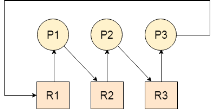
Fig 1 - Deadlock
Difference between Starvation and Deadlock
Sr. | Deadlock | Starvation |
1 | Deadlock is a situation where no process got blocked and no process proceeds . | Starvation is a situation where the low priority process got blocked and the high priority processes proceed. |
2 | Deadlock is an infinite waiting. | Starvation is a long waiting but not infinite. |
3 | Every Deadlock is always a starvation. | Every starvation need not be deadlock. |
4 | The requested resource is blocked by the other process. | The requested resource is continuously be used by the higher priority processes. |
5 | Deadlock happens when Mutual exclusion, hold and wait, No preemption and circular wait occurs simultaneously. | It occurs due to the uncontrolled priority and resource management. |
Necessary conditions for Deadlocks:
A resource can only be shared in mutually exclusive manner. It implies, if two process cannot use the same resource at the same time.
2. Hold and Wait:
A process waits for some resources while holding another resource at the same time.
3. No pre-emption:
The process which once scheduled will be executed till the completion. No other process can be scheduled by the scheduler meanwhile.
4. Circular Wait:
All the processes must be waiting for the resources in a cyclic manner so that the last process is waiting for the resource which is being held by the first process.
Key takeaway:
Every process needs some resources to complete its execution. However, the resource is granted in a sequential order.
A Deadlock is a situation where each of the computer process waits for a resource which is being assigned to some another process. In this situation, none of the process gets executed since the resource it needs, is held by some other process which is also waiting for some other resource to be released.
Strategies for handling Deadlock-
1. Deadlock Ignorance:
Deadlock Ignorance is the most widely used approach among all the mechanism. This is being used by many operating systems mainly for end user uses. In this approach, the Operating system assumes that deadlock never occurs. It simply ignores deadlock. This approach is best suitable for a single end user system where User uses the system only for browsing and all other normal stuff.
There is always a tradeoff between Correctness and performance. The operating systems like Windows and Linux mainly focus upon performance. However, the performance of the system decreases if it uses deadlock handling mechanism all the time if deadlock happens 1 out of 100 times then it is completely unnecessary to use the deadlock handling mechanism all the time.
In these types of systems, the user has to simply restart the computer in the case of deadlock. Windows and Linux are mainly using this approach.
2. Deadlock prevention :
Deadlock happens only when Mutual Exclusion, hold and wait, No preemption and circular wait holds simultaneously. If it is possible to violate one of the four conditions at any time then the deadlock can never occur in the system.
The idea behind the approach is very simple that we have to fail one of the four conditions but there can be a big argument on its physical implementation in the system.
We will discuss it later in detail.
3. Deadlock avoidance:
In deadlock avoidance, the operating system checks whether the system is in safe state or in unsafe state at every step which the operating system performs. The process continues until the system is in safe state. Once the system moves to unsafe state, the OS has to backtrack one step.
In simple words, The OS reviews each allocation so that the allocation doesn't cause the deadlock in the system.
We will discuss Deadlock avoidance later in detail.
4. Deadlock detection and recovery:
This approach let the processes fall in deadlock and then periodically check whether deadlock occur in the system or not. If it occurs then it applies some of the recovery methods to the system to get rid of deadlock.
Deadlock Prevention-
If we simulate deadlock with a table which is standing on its four legs then we can also simulate four legs with the four conditions which when occurs simultaneously, cause the deadlock.
However, if we break one of the legs of the table then the table will fall definitely. The same happens with deadlock, if we can be able to violate one of the four necessary conditions and don't let them occur together then we can prevent the deadlock.
Let's see how we can prevent each of the conditions.
1. Mutual Exclusion:
Mutual section from the resource point of view is the fact that a resource can never be used by more than one process simultaneously which is fair enough but that is the main reason behind the deadlock. If a resource could have been used by more than one process at the same time then the process would have never been waiting for any resource.
However, if we can be able to violate resources behaving in the mutually exclusive manner then the deadlock can be prevented.
Spooling:
For a device like printer, spooling can work. There is a memory associated with the printer which stores jobs from each of the process into it. Later, Printer collects all the jobs and print each one of them according to FCFS. By using this mechanism, the process doesn't have to wait for the printer and it can continue whatever it was doing. Later, it collects the output when it is produced.
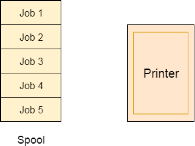
Fig 2 - Spool
Although, Spooling can be an effective approach to violate mutual exclusion but it suffers from two kinds of problems.
We cannot force a resource to be used by more than one process at the same time since it will not be fair enough and some serious problems may arise in the performance. Therefore, we cannot violate mutual exclusion for a process practically.
2. Hold and Wait:
Hold and wait condition lies when a process holds a resource and waiting for some other resource to complete its task. Deadlock occurs because there can be more than one process which are holding one resource and waiting for other in the cyclic order.
However, we have to find out some mechanism by which a process either doesn't hold any resource or doesn't wait. That means, a process must be assigned all the necessary resources before the execution starts. A process must not wait for any resource once the execution has been started.
!(Hold and wait) = !hold or !wait (negation of hold and wait is, either you don't hold or you don't wait)
This can be implemented practically if a process declares all the resources initially. However, this sounds very practical but can't be done in the computer system because a process can't determine necessary resources initially.
Process is the set of instructions which are executed by the CPU. Each of the instruction may demand multiple resources at the multiple times. The need cannot be fixed by the OS.
The problem with the approach is:
3. No Preemption:
Deadlock arises due to the fact that a process can't be stopped once it starts. However, if we take the resource away from the process which is causing deadlock then we can prevent deadlock.
This is not a good approach at all since if we take a resource away which is being used by the process then all the work which it has done till now can become inconsistent.
Consider a printer is being used by any process. If we take the printer away from that process and assign it to some other process then all the data which has been printed can become inconsistent and ineffective and also the fact that the process can't start printing again from where it has left which causes performance inefficiency.
4. Circular Wait:
To violate circular wait, we can assign a priority number to each of the resource. A process can't request for a lesser priority resource. This ensures that not a single process can request a resource which is being utilized by some other process and no cycle will be formed.
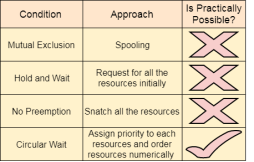
Fig 3 – Circular wait
Among all the methods, violating Circular wait is the only approach that can be implemented practically.
Deadlock avoidance:
In deadlock avoidance, the request for any resource will be granted if the resulting state of the system doesn't cause deadlock in the system. The state of the system will continuously be checked for safe and unsafe states.
In order to avoid deadlocks, the process must tell OS, the maximum number of resources a process can request to complete its execution.
The simplest and most useful approach states that the process should declare the maximum number of resources of each type it may ever need. The Deadlock avoidance algorithm examines the resource allocations so that there can never be a circular wait condition.
Safe and Unsafe States:
The resource allocation state of a system can be defined by the instances of available and allocated resources, and the maximum instance of the resources demanded by the processes.
A state of a system recorded at some random time is shown below.
Resources Assigned:
Process | Type 1 | Type 2 | Type 3 | Type 4 |
A | 3 | 0 | 2 | 2 |
B | 0 | 0 | 1 | 1 |
C | 1 | 1 | 1 | 0 |
D | 2 | 1 | 4 | 0 |
Process | Type 1 | Type 2 | Type 3 | Type 4 |
A | 1 | 1 | 0 | 0 |
B | 0 | 1 | 1 | 2 |
C | 1 | 2 | 1 | 0 |
D | 2 | 1 | 1 | 2 |
Above tables and vector E, P and A describes the resource allocation state of a system. There are 4 processes and 4 types of the resources in a system. Table 1 shows the instances of each resource assigned to each process.
Table 2 shows the instances of the resources, each process still needs. Vector E is the representation of total instances of each resource in the system.
Vector P represents the instances of resources that have been assigned to processes. Vector A represents the number of resources that are not in use.
A state of the system is called safe if the system can allocate all the resources requested by all the processes without entering into deadlock.
If the system cannot fulfill the request of all processes then the state of the system is called unsafe.
The key of Deadlock avoidance approach is when the request is made for resources then the request must only be approved in the case if the resulting state is also a safe state.
Deadlock Detection and Recovery:
In this approach, The OS doesn't apply any mechanism to avoid or prevent the deadlocks. Therefore the system considers that the deadlock will definitely occur. In order to get rid of deadlocks, The OS periodically checks the system for any deadlock. In case, it finds any of the deadlock then the OS will recover the system using some recovery techniques.
The main task of the OS is detecting the deadlocks. The OS can detect the deadlocks with the help of Resource allocation graph.
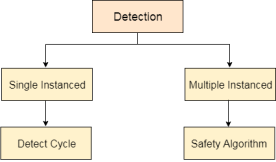
Fig 4 - Detection
In single instanced resource types, if a cycle is being formed in the system then there will definitely be a deadlock. On the other hand, in multiple instanced resource type graph, detecting a cycle is not just enough. We have to apply the safety algorithm on the system by converting the resource allocation graph into the allocation matrix and request matrix.
In order to recover the system from deadlocks, either OS considers resources or processes.
For Resource-
Preempt the resource:
We can snatch one of the resources from the owner of the resource (process) and give it to the other process with the expectation that it will complete the execution and will release this resource sooner. Well, choosing a resource which will be snatched is going to be a bit difficult.
Rollback to a safe state:
System passes through various states to get into the deadlock state. The operating system canrollback the system to the previous safe state. For this purpose, OS needs to implement check pointing at every state.
The moment, we get into deadlock, we will rollback all the allocations to get into the previous safe state.
For Process-
Kill a process:
Killing a process can solve our problem but the bigger concern is to decide which process to kill. Generally, Operating system kills a process which has done least amount of work until now.
Kill all process:
This is not a suggestible approach but can be implemented if the problem becomes very serious. Killing all process will lead to inefficiency in the system because all the processes will execute again from starting.
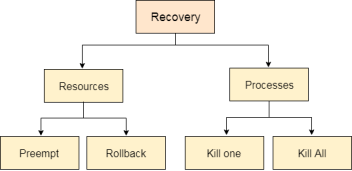
Fig 5 – Recovery
Key takeaway-
Deadlock Ignorance is the most widely used approach among all the mechanism. This is being used by many operating systems mainly for end user uses. In this approach, the Operating system assumes that deadlock never occurs. It simply ignores deadlock. This approach is best suitable for a single end user system where User uses the system only for browsing and all other normal stuff.
There is always a tradeoff between Correctness and performance. The operating systems like Windows and Linux mainly focus upon performance. However, the performance of the system decreases if it uses deadlock handling mechanism all the time if deadlock happens 1 out of 100 times then it is completely unnecessary to use the deadlock handling mechanism all the time.
In these types of systems, the user has to simply restart the computer in the case of deadlock. Windows and Linux are mainly using this approach.
Memory Hierarchy:
A memory unit is an essential component in any digital computer since it is needed for storing programs and data.
Typically, a memory unit can be classified into two categories:
Apart from the basic classifications of a memory unit, the memory hierarchy consists all of the storage devices available in a computer system ranging from the slow but high-capacity auxiliary memory to relatively faster main memory.
The following image illustrates the components in a typical memory hierarchy.

Fig 6 – Memory hierarchy in a computer system
Auxiliary Memory:
Auxiliary memory is known as the lowest-cost, highest-capacity and slowest-access storage in a computer system. Auxiliary memory provides storage for programs and data that are kept for long-term storage or when not in immediate use. The most common examples of auxiliary memories are magnetic tapes and magnetic disks.
A magnetic disk is a digital computer memory that uses a magnetization process to write, rewrite and access data. For example, hard drives, zip disks, and floppy disks.
Magnetic tape is a storage medium that allows for data archiving, collection, and backup for different kinds of data.
Main Memory:
The main memory in a computer system is often referred to as Random Access Memory (RAM). This memory unit communicates directly with the CPU and with auxiliary memory devices through an I/O processor.
The programs that are not currently required in the main memory are transferred into auxiliary memory to provide space for currently used programs and data.
I/O Processor:
The primary function of an I/O Processor is to manage the data transfers between auxiliary memories and the main memory.
Cache Memory:
The data or contents of the main memory that are used frequently by CPU are stored in the cache memory so that the processor can easily access that data in a shorter time. Whenever the CPU requires accessing memory, it first checks the required data into the cache memory. If the data is found in the cache memory, it is read from the fast memory. Otherwise, the CPU moves onto the main memory for the required data.
Memory management is the functionality of an operating system which handles or manages primary memory and moves processes back and forth between main memory and disk during execution. Memory management keeps track of each and every memory location, regardless of either it is allocated to some process or it is free. It checks how much memory is to be allocated to processes. It decides which process will get memory at what time. It tracks whenever some memory gets freed or unallocated and correspondingly it updates the status.
Process Address Space:
The process address space is the set of logical addresses that a process references in its code. For example, when 32-bit addressing is in use, addresses can range from 0 to 0x7fffffff; that is, 2^31 possible numbers, for a total theoretical size of 2 gigabytes.
The operating system takes care of mapping the logical addresses to physical addresses at the time of memory allocation to the program. There are three types of addresses used in a program before and after memory is allocated −
S.N. | Memory Addresses & Description |
| Symbolic addresses: The addresses used in a source code. The variable names, constants, and instruction labels are the basic elements of the symbolic address space.
|
| Relative addresses: At the time of compilation, a compiler converts symbolic addresses into relative addresses.
|
| Physical addresses: The loader generates these addresses at the time when a program is loaded into main memory. |
Virtual and physical addresses are the same in compile-time and load-time address-binding schemes. Virtual and physical addresses differ in execution-time address-binding scheme.
The set of all logical addresses generated by a program is referred to as a logical address space. The set of all physical addresses corresponding to these logical addresses is referred to as a physical address space.
The runtime mapping from virtual to physical address is done by the memory management unit (MMU) which is a hardware device. MMU uses following mechanism to convert virtual address to physical address.
Static vs Dynamic Loading:
The choice between Static or Dynamic Loading is to be made at the time of computer program being developed. If you have to load your program statically, then at the time of compilation, the complete programs will be compiled and linked without leaving any external program or module dependency. The linker combines the object program with other necessary object modules into an absolute program, which also includes logical addresses.
If you are writing a Dynamically loaded program, then your compiler will compile the program and for all the modules which you want to include dynamically, only references will be provided and rest of the work will be done at the time of execution.
At the time of loading, with static loading, the absolute program (and data) is loaded into memory in order for execution to start.
If you are using dynamic loading, dynamic routines of the library are stored on a disk in relocatable form and are loaded into memory only when they are needed by the program.
Static vs Dynamic Linking:
As explained above, when static linking is used, the linker combines all other modules needed by a program into a single executable program to avoid any runtime dependency.
When dynamic linking is used, it is not required to link the actual module or library with the program, rather a reference to the dynamic module is provided at the time of compilation and linking. Dynamic Link Libraries (DLL) in Windows and Shared Objects in Unix are good examples of dynamic libraries.
Swapping:
Swapping is a mechanism in which a process can be swapped temporarily out of main memory (or move) to secondary storage (disk) and make that memory available to other processes. At some later time, the system swaps back the process from the secondary storage to main memory.
Though performance is usually affected by swapping process but it helps in running multiple and big processes in parallel and that's the reason Swapping is also known as a technique for memory compaction.

Fig 7 - Swapping
The total time taken by swapping process includes the time it takes to move the entire process to a secondary disk and then to copy the process back to memory, as well as the time the process takes to regain main memory.
Let us assume that the user process is of size 2048KB and on a standard hard disk where swapping will take place has a data transfer rate around 1 MB per second. The actual transfer of the 1000K process to or from memory will take
2048KB / 1024KB per second
= 2 seconds
= 2000 milliseconds
Now considering in and out time, it will take complete 4000 milliseconds plus other overhead where the process competes to regain main memory.
Memory Allocation
Main memory usually has two partitions −
Operating system uses the following memory allocation mechanism.
S.N. | Memory Allocation & Description |
| Single-partition allocation: In this type of allocation, relocation-register scheme is used to protect user processes from each other, and from changing operating-system code and data. Relocation register contains value of smallest physical address whereas limit register contains range of logical addresses. Each logical address must be less than the limit register.
|
| Multiple-partition allocation: In this type of allocation, main memory is divided into a number of fixed-sized partitions where each partition should contain only one process. When a partition is free, a process is selected from the input queue and is loaded into the free partition. When the process terminates, the partition becomes available for another process. |
Fragmentation:
As processes are loaded and removed from memory, the free memory space is broken into little pieces. It happens after sometimes that processes cannot be allocated to memory blocks considering their small size and memory blocks remains unused. This problem is known as Fragmentation.
Fragmentation is of two types −
S.N. | Fragmentation & Description |
| External fragmentation: Total memory space is enough to satisfy a request or to reside a process in it, but it is not contiguous, so it cannot be used.
|
| Internal fragmentation: Memory block assigned to process is bigger. Some portion of memory is left unused, as it cannot be used by another process. |
The following diagram shows how fragmentation can cause waste of memory and a compaction technique can be used to create more free memory out of fragmented memory −
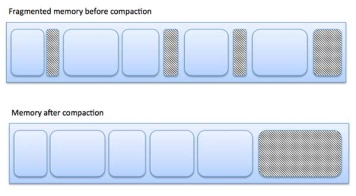
Fig 8 - Fragmentation
External fragmentation can be reduced by compaction or shuffle memory contents to place all free memory together in one large block. To make compaction feasible, relocation should be dynamic.
The internal fragmentation can be reduced by effectively assigning the smallest partition but large enough for the process.
Paging:
A computer can address more memory than the amount physically installed on the system. This extra memory is actually called virtual memory and it is a section of a hard that's set up to emulate the computer's RAM. Paging technique plays an important role in implementing virtual memory.
Paging is a memory management technique in which process address space is broken into blocks of the same size called pages (size is power of 2, between 512 bytes and 8192 bytes). The size of the process is measured in the number of pages.
Similarly, main memory is divided into small fixed-sized blocks of (physical) memory called frames and the size of a frame is kept the same as that of a page to have optimum utilization of the main memory and to avoid external fragmentation.
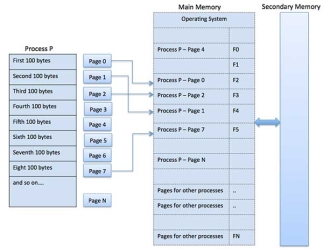
Fig 9 – Memory state
Address Translation:
Page address is called logical address and represented by page number and the offset.
Logical Address = Page number + page offset
Frame address is called physical address and represented by a frame number and the offset.
Physical Address = Frame number + page offset
A data structure called page map table is used to keep track of the relation between a page of a process to a frame in physical memory.
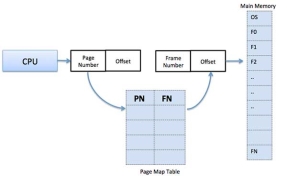
Fig 10 – Page map table
When the system allocates a frame to any page, it translates this logical address into a physical address and create entry into the page table to be used throughout execution of the program.
When a process is to be executed, its corresponding pages are loaded into any available memory frames. Suppose you have a program of 8Kb but your memory can accommodate only 5Kb at a given point in time, then the paging concept will come into picture. When a computer runs out of RAM, the operating system (OS) will move idle or unwanted pages of memory to secondary memory to free up RAM for other processes and brings them back when needed by the program.
This process continues during the whole execution of the program where the OS keeps removing idle pages from the main memory and write them onto the secondary memory and bring them back when required by the program.
Advantages and Disadvantages of Paging:
Here is a list of advantages and disadvantages of paging −
Segmentation:
Segmentation is a memory management technique in which each job is divided into several segments of different sizes, one for each module that contains pieces that perform related functions. Each segment is actually a different logical address space of the program.
When a process is to be executed, its corresponding segmentation are loaded into non-contiguous memory though every segment is loaded into a contiguous block of available memory.
Segmentation memory management works very similar to paging but here segments are of variable-length where as in paging pages are of fixed size.
A program segment contains the program's main function, utility functions, data structures, and so on. The operating system maintains a segment map table for every process and a list of free memory blocks along with segment numbers, their size and corresponding memory locations in main memory. For each segment, the table stores the starting address of the segment and the length of the segment. A reference to a memory location includes a value that identifies a segment and an offset.

Fig 11 – Segmentation
Key takeaway-
A memory unit is an essential component in any digital computer since it is needed for storing programs and data.
Typically, a memory unit can be classified into two categories:
The heap is the portion of the store that is used for data that lives indefinitely, or until the program explicitly deletes it. While local variables typically become inaccessible when their procedures end, many languages enable us to create objects or other data whose existence is not tied to the procedure activation that creates them. For example, both C + + and Java give the programmer new to create objects that may be passed — or pointers to them may be passed — from procedure to procedure, so they continue to exist long after the procedure that created them is gone. Such objects are stored on a heap.
In this section, we discuss the memory manager, the subsystem that allo-cates and deallocates space within the heap; it serves as an interface between application programs and the operating system. For languages like C or C + + that deallocate chunks of storage manually (i.e., by explicit statements of the program, such as free or delete ) , the memory manager is also responsible for implementing deallocation.
In Section 7.5, we discuss garbage collection, which is the process of finding spaces within the heap that are no longer used by the program and can therefore be reallocated to house other data items. For languages like Java, it is the garbage collector that deallocates memory. When it is required, the garbage collector is an important subsystem of the memory manager.
1. The Memory Manager:
The memory manager keeps track of all the free space in heap storage at all times. It performs two basic functions:
• Allocation. When a program requests memory for a variable or object,3 the memory manager produces a chunk of contiguous heap memory of the requested size. If possible, it satisfies an allocation request using free space in the heap; if no chunk of the needed size is available, it seeks to increase the heap storage space by getting consecutive bytes of virtual memory from the operating system. If space is exhausted, the memory manager passes that information back to the application program.
• Deallocation. The memory manager returns deallocated space to the pool of free space, so it can reuse the space to satisfy other allocation requests. Memory managers typically do not return memory to the operating sys-tem, even if the program's heap usage drops.
Memory management would be simpler if (a) all allocation requests were for chunks of the same size, and (b) storage were released predictably, say, first-allocated first-deallocated. There are some languages, such as Lisp, for which condition (a) holds; pure Lisp uses only one data element — a two- pointer cell — from which all data structures are built. Condition (b) also holds in some situations, the most common being data that can be allocated on the run-time stack. However, in most languages, neither (a) nor (b) holds in general. Rather, data elements of different sizes are allocated, and there is no good way to predict the lifetimes of all allocated objects.
Thus, the memory manager must be prepared to service, in any order, allo-cation and deallocation requests of any size, ranging from one byte to as large as the program's entire address space.
Here are the properties we desire of memory managers:
• Space Efficiency. A memory manager should minimize the total heap space needed by a program. Doing so allows larger programs to run in a fixed virtual address space. Space efficiency is achieved by minimizing "fragmentation," discussed in Section 7.4.4.
• Program Efficiency. A memory manager should make good use of the memory subsystem to allow programs to run faster. As we shall see in Section 7.4.2, the time taken to execute an instruction can vary widely depending on where objects are placed in memory. Fortunately, programs tend to exhibit "locality," a phenomenon discussed in Section 7.4.3, which refers to the nonrandom clustered way in which typical programs access memory. By attention to the placement of objects in memory, the memory manager can make better use of space and, hopefully, make the program run faster.
• Low Overhead. Because memory allocations and deallocations are fre-quent operations in many programs, it is important that these operations be as efficient as possible. That is, we wish to minimize the overhead — the fraction of execution time spent performing allocation and dealloca-tion. Notice that the cost of allocations is dominated by small requests; the overhead of managing large objects is less important, because it usu-ally can be amortized over a larger amount of computation.
2. The Memory Hierarchy of a Computer:
Memory management and compiler optimization must be done with an aware-ness of how memory behaves. Modern machines are designed so that program-mers can write correct programs without concerning themselves with the details of the memory subsystem. However, the efficiency of a program is determined not just by the number of instructions executed, but also by how long it takes to execute each of these instructions. The time taken to execute an instruction can vary significantly, since the time taken to access different parts of memory can vary from nanoseconds to milliseconds. Data-intensive programs can there-fore benefit significantly from optimizations that make good use of the memory subsystem. As we shall see in Section 7.4.3, they can take advantage of the phenomenon of "locality" — the nonrandom behavior of typical programs.
The large variance in memory access times is due to the fundamental limitation in hardware technology; we can build small and fast storage, or large and slow storage, but not storage that is both large and fast. It is simply impossible today to build gigabytes of storage with nanosecond access times, which is how fast high-performance processors run. Therefore, practically all modern computers arrange their storage as a memory hierarchy. A memory hierarchy, as shown in Fig. 7.16, consists of a series of storage elements, with the smaller faster ones "closer" to the processor, and the larger slower ones further away.
Typically, a processor has a small number of registers, whose contents are under software control. Next, it has one or more levels of cache, usually made out of static RAM, that are kilobytes to several megabytes in size. The next level of the hierarchy is the physical (main) memory, made out of hundreds of megabytes or gigabytes of dynamic RAM. The physical memory is then backed up by virtual memory, which is implemented by gigabytes of disks. Upon a memory access, the machine first looks for the data in the closest (lowest-level) storage and, if the data is not there, looks in the next higher level, and so on.
Registers are scarce, so register usage is tailored for the specific applications and managed by the code that a compiler generates. All the other levels of the hierarchy are managed automatically; in this way, not only is the programming task simplified, but the same program can work effectively across machines with different memory configurations. With each memory access, the machine searches each level of the memory in succession, starting with the lowest level, until it locates the data. Caches are managed exclusively in hardware, in order to keep up with the relatively fast RAM access times. Because disks are rela
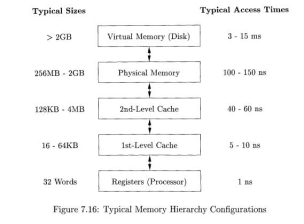
Fig 12 – Typical memory hierarchy configurations
tively slow, the virtual memory is managed by the operating system, with the assistance of a hardware structure known as the "translation lookaside buffer."
Data is transferred as blocks of contiguous storage. To amortize the cost of access, larger blocks are used with the slower levels of the hierarchy. Be-tween main memory and cache, data is transferred in blocks known as cache lines, which are typically from 32 to 256 bytes long. Between virtual memory (disk) and main memory, data is transferred in blocks known as pages, typically between 4K and 64K bytes in size.
3. Locality in Programs:
Most programs exhibit a high degree of locality; that is, they spend most of their time executing a relatively small fraction of the code and touching only a small fraction of the data. We say that a program has temporal locality if the memory locations it accesses are likely to be accessed again within a short period of time. We say that a program has spatial locality if memory locations close to the location accessed are likely also to be accessed within a short period of time.
The conventional wisdom is that programs spend 90% of their time executing 10% of the code. Here is why:
Programs often contain many instructions that are never executed. Pro-grams built with components and libraries use only a small fraction of the provided functionality. Also as requirements change and programs evolve, legacy systems often contain many instructions that are no longer used.
Static and Dynamic RAM:
Most random-access memory is dynamic, which means that it is built of very simple electronic circuits that lose their charge (and thus "forget" the bit they were storing) in a short time. These circuits need to be refreshed — that is, their bits read and rewritten — periodically. On the other hand, static RAM is designed with a more complex circuit for each bit, and consequently the bit stored can stay indefinitely, until it is changed. Evidently, a chip can store more bits if it uses dynamic-RAM circuits than if it uses static-RAM circuits, so we tend to see large main memories of the dynamic variety, while smaller memories, like caches, are made from static circuits.
• Only a small fraction of the code that could be invoked is actually executed in a typical run of the program. For example, instructions to handle illegal inputs and exceptional cases, though critical to the correctness of the program, are seldom invoked on any particular run.
The typical program spends most of its time executing innermost loops and tight recursive cycles in a program.
Locality allows us to take advantage of the memory hierarchy of a modern computer, as shown in Fig. 7.16. By placing the most common instructions and data in the fast-but-small storage, while leaving the rest in the slow-but-large storage, we can lower the average memory-access time of a program significantly.
It has been found that many programs exhibit both temporal and spatial locality in how they access both instructions and data. Data-access patterns, however, generally show a greater variance than instruction-access patterns. Policies such as keeping the most recently used data in the fastest hierarchy work well for common programs but may not work well for some data-intensive programs — ones that cycle through very large arrays, for example.
We often cannot tell, just from looking at the code, which sections of the code will be heavily used, especially for a particular input. Even if we know which instructions are executed heavily, the fastest cache often is not large enough to hold all of them at the same time. We must therefore adjust the contents of the fastest storage dynamically and use it to hold instructions that are likely to be used heavily in the near future.
Optimization Using the Memory Hierarchy:
The policy of keeping the most recently used instructions in the cache tends to work well; in other words, the past is generally a good predictor of future memory usage. When a new instruction is executed, there is a high probability that the next instruction also will be executed. This phenomenon is an example of spatial locality. One effective technique to improve the spatial lo-cality of instructions is to have the compiler place basic blocks (sequences of instructions that are always executed sequentially) that are likely to follow each other contiguously — on the same page, or even the same cache line, if possi-ble. Instructions belonging to the same loop or same function also have a high probability of being executed together.4
We can also improve the temporal and spatial locality of data accesses in a program by changing the data layout or the order of the computation. For example, programs that visit large amounts of data repeatedly, each time per-forming a small amount of computation, do not perform well. It is better if we can bring some data from a slow level of the memory hierarchy to a faster level (e.g., disk to main memory) once, and perform all the necessary computations on this data while it resides at the faster level. This concept can be applied recursively to reuse data in physical memory, in the caches and in the registers.
4. Reducing Fragmentation:
At the beginning of program execution, the heap is one contiguous unit of free space. As the program allocates and deallocates memory, this space is broken up into free and used chunks of memory, and the free chunks need not reside in a contiguous area of the heap. We refer to the free chunks of memory as holes. With each allocation request, the memory manager must place the requested chunk of memory into a large-enough hole. Unless a hole of exactly the right size is found, we need to split some hole, creating a yet smaller hole.
With each deallocation request, the freed chunks of memory are added back to the pool of free space. We coalesce contiguous holes into larger holes, as the holes can only get smaller otherwise. If we are not careful, the memory may end up getting fragmented, consisting of large numbers of small, noncontiguous holes. It is then possible that no hole is large enough to satisfy a future request, even though there may be sufficient aggregate free space.
Best - Fit and Next - Fit Object Placement
We reduce fragmentation by controlling how the memory manager places new objects in the heap. It has been found empirically that a good strategy for mini-mizing fragmentation for real-life programs is to allocate the requested memory in the smallest available hole that is large enough. This best-fit algorithm tends to spare the large holes to satisfy subsequent, larger requests. An alternative, called first-fit, where an object is placed in the first (lowest-address) hole in which it fits, takes less time to place objects, but has been found inferior to best-fit in overall performance.
To implement best-fit placement more efficiently, we can separate free space into bins, according to their sizes. One practical idea is to have many more bins for the smaller sizes, because there are usually many more small objects. For example, the Lea memory manager, used in the GNU C compiler gcc, aligns all chunks to 8-byte boundaries. There is a bin for every multiple of 8-byte chunks from 16 bytes to 512 bytes. Larger-sized bins are logarithmically spaced (i.e., the minimum size for each bin is twice that of the previous bin), and within each of these bins the chunks are ordered by their size. There is always a chunk of free space that can be extended by requesting more pages from the operating system. Called the wilderness chunk, this chunk is treated by Lea as the largest-sized bin because of its extensibility.
Binning makes it easy to find the best-fit chunk.
If, as for small sizes requested from the Lea memory manager, there is a bin for chunks of that size only, we may take any chunk from that bin.
For sizes that do not have a private bin, we find the one bin that is allowed to include chunks of the desired size. Within that bin, we can use either a first-fit or a best-fit strategy; i.e., we either look for and select the first chunk that is sufficiently large or, we spend more time and find the smallest chunk that is sufficiently large. Note that when the fit is not exact, the remainder of the chunk will generally need to be placed in a bin with smaller sizes.
However, it may be that the target bin is empty, or all chunks in that bin are too small to satisfy the request for space. In that case, we simply repeat the search, using the bin for the next larger size(s). Eventually, we either find a chunk we can use, or we reach the "wilderness" chunk, from which we can surely obtain the needed space, possibly by going to the operating system and getting additional pages for the heap.
While best-fit placement tends to improve space utilization, it may not be the best in terms of spatial locality. Chunks allocated at about the same time by a program tend to have similar reference patterns and to have similar lifetimes. Placing them close together thus improves the program's spatial locality. One useful adaptation of the best-fit algorithm is to modify the placement in the case when a chunk of the exact requested size cannot be found. In this case, we use a next-fit strategy, trying to allocate the object in the chunk that has last been split, whenever enough space for the new object remains in that chunk. Next-fit also tends to improve the speed of the allocation operation.
Managing and Coalescing Free Space:
When an object is deallocated manually, the memory manager must make its chunk free, so it can be allocated again. In some circumstances, it may also be possible to combine (coalesce) that chunk with adjacent chunks of the heap, to form a larger chunk. There is an advantage to doing so, since we can always use a large chunk to do the work of small chunks of equal total size, but many small chunks cannot hold one large object, as the combined chunk could.
If we keep a bin for chunks of one fixed size, as Lea does for small sizes, then we may prefer not to coalesce adjacent blocks of that size into a chunk of double the size. It is simpler to keep all the chunks of one size in as many pages as we need, and never coalesce them. Then, a simple allocation/deallocation scheme is to keep a bitmap, with one bit for each chunk in the bin. A 1 indicates the chunk is occupied; 0 indicates it is free. When a chunk is deallocated, we change its 1 to a 0. When we need to allocate a chunk, we find any chunk with a 0 bit, change that bit to a 1, and use the corresponding chunk. If there are no free chunks, we get a new page, divide it into chunks of the appropriate size, and extend the bit vector.
Matters are more complex when the heap is managed as a whole, without binning, or if we are willing to coalesce adjacent chunks and move the resulting chunk to a different bin if necessary. There are two data structures that are useful to support coalescing of adjacent free blocks:
• Boundary Tags. At both the low and high ends of each chunk, whether free or allocated, we keep vital information. At both ends, we keep a free/used bit that tells whether or not the block is currently allocated (used) or available (free). Adjacent to each free/used bit is a count of the total number of bytes in the chunk.
• A Doubly Linked, Embedded Free List. The free chunks (but not the allocated chunks) are also linked in a doubly linked list. The pointers for this list are within the blocks themselves, say adjacent to the boundary tags at either end. Thus, no additional space is needed for the free list, although its existence does place a lower bound on how small chunks can get; they must accommodate two boundary tags and two pointers, even if the object is a single byte. The order of chunks on the free list is left unspecified. For example, the list could be sorted by size, thus facilitating best-fit placement.
Example 7 . 1 0 : Figure 7.17 shows part of a heap with three adjacent chunks, A, B, and C. Chunk B: of size 100, has just been deallocated and returned to the free list. Since we know the beginning (left end) of 5, we also know the end of the chunk that happens to be immediately to B's left, namely A in this example. The free/used bit at the right end of A is currently 0, so A too is free. We may therefore coalesce A and B into one chunk of 300 bytes.

Fig 13 – Part of a heap and a doubly linked free list
It might be the case that chunk C, the chunk immediately to B's right, is also free, in which case we can combine all of A, B, and C. Note that if we always coalesce chunks when we can, then there can never be two adjacent free chunks, so we never have to look further than the two chunks adjacent to the one being deallocated. In the current case, we find the beginning of C by starting at the left end of B, which we know, and finding the total number of bytes in B, which is found in the left boundary tag of B and is 100 bytes. With this information, we find the right end of B and the beginning of the chunk to its right. At that point, we examine the free/used bit of C and find that it is 1 for used; hence, C is not available for coalescing.
Since we must coalesce A and B, we need to remove one of them from the free list. The doubly linked free-list structure lets us find the chunks before and after each of A and B. Notice that it should not be assumed that physical neighbors A and B are also adjacent on the free list. Knowing the chunks preceding and following A and B on the free list, it is straightforward to manipulate pointers on the list to replace A and B by one coalesced chunk. •
Automatic garbage collection can eliminate fragmentation altogether if it moves all the allocated objects to contiguous storage. The interaction between garbage collection and memory management is discussed in more detail in Sec-tion 7.6.4.
5. Manual Deallocation Requests:
We close this section with manual memory management, where the programmer must explicitly arrange for the deallocation of data, as in C and C + + . Ideally, any storage that will no longer be accessed should be deleted. Conversely, any storage that may be referenced must not be deleted. Unfortunately, it is hard to enforce either of these properties. In addition to considering the difficulties with manual deallocation, we shall describe some of the techniques programmers use to help with the difficulties.
Problems with Manual Deallocation:
Manual memory management is error-prone. The common mistakes take two forms: failing ever to delete data that cannot be referenced is called a memory-leak error, and referencing deleted data is a dangling-pointer-dereference error.
It is hard for programmers to tell if a program will never refer to some stor-age in the future, so the first common mistake is not deleting storage that will never be referenced. Note that although memory leaks may slow down the exe-cution of a program due to increased memory usage, they do not affect program correctness, as long as the machine does not run out of memory. Many pro-grams can tolerate memory leaks, especially if the leakage is slow. However, for long-running programs, and especially nonstop programs like operating systems or server code, it is critical that they not have leaks.
Automatic garbage collection gets rid of memory leaks by deallocating all the garbage. Even with automatic garbage collection, a program may still use more memory than necessary. A programmer may know that an object will never be referenced, even though references to that object exist somewhere. In that case, the programmer must deliberately remove references to objects that will never be referenced, so the objects can be deallocated automatically.
Being overly zealous about deleting objects can lead to even worse problems than memory leaks. The second common mistake is to delete some storage and then try to refer to the data in the deallocated storage. Pointers to storage that has been deallocated are known as dangling pointers. Once the freed storage has been reallocated to a new variable, any read, write, or deallocation via the dangling pointer can produce seemingly random effects. We refer to any operation, such as read, write, or deallocate, that follows a pointer and tries to use the object it points to, as dereferencing the pointer.
Notice that reading through a dangling pointer may return an arbitrary value. Writing through a dangling pointer arbitrarily changes the value of the new variable. Deallocating a dangling pointer's storage means that the storage of the new variable may be allocated to yet another variable, and actions on the old and new variables may conflict with each other.
Unlike memory leaks, dereferencing a dangling pointer after the freed storage is reallocated almost always creates a program error that is hard to debug. As a result, programmers are more inclined not to deallocate a variable if they are not certain it is unreferencable.
A related form of programming error is to access an illegal address. Common examples of such errors include dereferencing null pointers and accessing an out-of-bounds array element. It is better for such errors to be detected than to have the program silently corrupt the results. In fact, many security violations exploit programming errors of this type, where certain program inputs allow unintended access to data, leading to a "hacker" taking control of the program and machine. One antidote is to have the compiler insert checks with every access, to make sure it is within bounds. The compiler's optimizer can discover and remove those checks that are not really necessary because the optimizer can deduce that the access must be within bounds.
An Example: Purify:
Rational's Purify is one of the most popular commercial tools that helps programmers find memory access errors and memory leaks in programs. Purify instruments binary code by adding additional instructions to check for errors as the program executes. It keeps a map of memory to indicate where all the freed and used spaces are. Each allocated object is bracketed with extra space; accesses to unallocated locations or to spaces between objects are flagged as errors. This approach finds some dangling pointer references, but not when the memory has been reallocated and a valid object is sitting in its place. This approach also finds some out-of-bound array accesses, if they happen to land in the space inserted at the end of the objects.
Purify also finds memory leaks at the end of a program execution. It searches the contents of all the allocated objects for possible pointer values. Any object without a pointer to it is a leaked chunk of memory. Purify reports the amount of memory leaked and the locations of the leaked objects. We may compare Purify to a "conservative garbage collector," which will be discussed in Section 7.8.3. and machine. One antidote is to have the compiler insert checks with every access, to make sure it is within bounds. The compiler's optimizer can discover and remove those checks that are not really necessary because the optimizer can deduce that the access must be within bounds.
Programming Conventions and Tools:
We now present a few of the most popular conventions and tools that have been developed to help programmers cope with the complexity in managing memory:
• Object ownership is useful when an object's lifetime can be statically rea-soned about. The idea is to associate an owner with each object at all times. The owner is a pointer to that object, presumably belonging to some function invocation. The owner (i.e., its function) is responsible for either deleting the object or for passing the object to another owner. It is possible to have other, nonowning pointers to the same object; these pointers can be overwritten any time, and no deletes should ever be ap-plied through them. This convention eliminates memory leaks, as well as attempts to delete the same object twice. However, it does not help solve the dangling-pointer-reference problem, because it is possible to follow a nonowning pointer to an object that has been deleted.
Reference counting is useful when an object's lifetime needs to be deter-mined dynamically. The idea is to associate a count with each dynamically allocated object. Whenever a reference to the object is created, we incre-ment the reference count; whenever a reference is removed, we decrement the reference count. When the count goes to zero, the object can no longer be referenced and can therefore be deleted. This technique, however, does not catch useless, circular data structures, where a collection of objects cannot be accessed, but their reference counts are not zero, since they refer to each other. For an illustration of this problem, see Example 7.11. Reference counting does eradicate all dangling-pointer references, since there are no outstanding references to any deleted objects. Reference counting is expensive because it imposes an overhead on every operation that stores a pointer.
• Region-based allocation is useful for collections of objects whose lifetimes are tied to specific phases in a computation.When objects are created to be used only within some step of a computation, we can allocate all such objects in the same region. We then delete the entire region once that computation step completes. This region-based allocation technique has limited applicability. However, it is very efficient whenever it can be used; instead of deallocating objects one at a time, it deletes all objects in the region in a wholesale fashion.
Key takeaway-
The heap is the portion of the store that is used for data that lives indefinitely, or until the program explicitly deletes it. While local variables typically become inaccessible when their procedures end, many languages enable us to create objects or other data whose existence is not tied to the procedure activation that creates them. For example, both C + + and Java give the programmer new to create objects that may be passed — or pointers to them may be passed — from procedure to procedure, so they continue to exist long after the procedure that created them is gone. Such objects are stored on a heap.
1. Contiguous Memory Allocation:
Contiguous memory allocation is basically a method in which a single contiguous section/part of memory is allocated to a process or file needing it. Because of this all the available memory space resides at the same place together, which means that the freely/unused available memory partitions are not distributed in a random fashion here and there across the whole memory space.
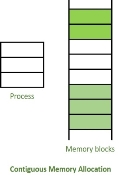
Fig 14 – Contiguous allocation
The main memory is a combination of two main portions- one for the operating system and other for the user program. We can implement/achieve contiguous memory allocation by dividing the memory partitions into fixed size partitions.
2. Non-Contiguous Memory Allocation :
Non-Contiguous memory allocation is basically a method on the contrary to contiguous allocation method, allocates the memory space present in different locations to the process as per it’s requirements. As all the available memory space is in a distributed pattern so the freely available memory space is also scattered here and there.
This technique of memory allocation helps to reduce the wastage of memory, which eventually gives rise to Internal and external fragmentation.
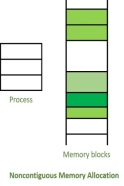
Fig 15 – Non-contiguous memory allocation
Difference between Contiguous and Non-contiguous Memory Allocation :
1. | Contiguous memory allocation Allocates consecutive blocks of memory to a file/process. | Non-Contiguous memory allocation Allocates separate blocks of memory to a file/process. |
2. | Faster in Execution. | Slower in Execution. |
3. | It is easier for the OS to control. | It is difficult for the OS to control. |
4. | Overhead is minimum as not much address translations are there while executing a process. | More Overheads are there as there are more address translations. |
5. | Internal fragmentation occurs in Contiguous memory allocation method. | External fragmentation occurs in Non-Contiguous memory allocation method. |
6. | It includes single partition allocation and multi-partition allocation. | It includes paging and segmentation. |
7. | Wastage of memory is there. | No memory wastage is there. |
8. | In contiguous memory allocation, swapped-in processes are arranged in the originally allocated space. | In non-contiguous memory allocation, swapped-in processes can be arranged in any place in the memory.
|
Key takeaway
Contiguous Memory Allocation:
Contiguous memory allocation is basically a method in which a single contiguous section/part of memory is allocated to a process or file needing it. Because of this all the available memory space resides at the same place together, which means that the freely/unused available memory partitions are not distributed in a random fashion here and there across the whole memory space.
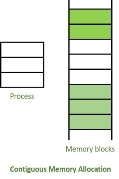
The main memory is a combination of two main portions- one for the operating system and other for the user program. We can implement/achieve contiguous memory allocation by dividing the memory partitions into fixed size partitions.
Segmentation:
In Operating Systems, Segmentation is a memory management technique in which, the memory is divided into the variable size parts. Each part is known as segment which can be allocated to a process.
The details about each segment are stored in a table called as segment table. Segment table is stored in one (or many) of the segments.
Segment table contains mainly two information about segment:
Why Segmentation is required?
Till now, we were using Paging as our main memory management technique. Paging is more close to Operating system rather than the User. It divides all the process into the form of pages regardless of the fact that a process can have some relative parts of functions which needs to be loaded in the same page.
Operating system doesn't care about the User's view of the process. It may divide the same function into different pages and those pages may or may not be loaded at the same time into the memory. It decreases the efficiency of the system.
It is better to have segmentation which divides the process into the segments. Each segment contain same type of functions such as main function can be included in one segment and the library functions can be included in the other segment,
Translation of Logical address into physical address by segment table.
CPU generates a logical address which contains two parts:
The Segment number is mapped to the segment table. The limit of the respective segment is compared with the offset. If the offset is less than the limit then the address is valid otherwise it throws an error as the address is invalid.
In the case of valid address, the base address of the segment is added to the offset to get the physical address of actual word in the main memory.
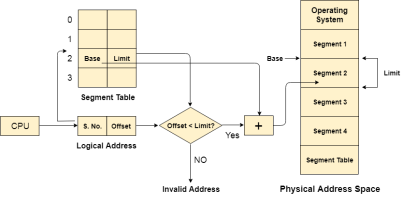
Fig 16 - The base address of the segment is added to the offset to get the physical address of actual word in the main memory.
Advantages of Segmentation:
Disadvantages
Paging VS Segmentation
Sr No. | Paging | Segmentation |
1 | Non-Contiguous memory allocation | Non-contiguous memory allocation |
2 | Paging divides program into fixed size pages. | Segmentation divides program into variable size segments. |
3 | OS is responsible | Compiler is responsible. |
4 | Paging is faster than segmentation | Segmentation is slower than paging |
5 | Paging is closer to Operating System | Segmentation is closer to User |
6 | It suffers from internal fragmentation | It suffers from external fragmentation |
7 | There is no external fragmentation | There is no external fragmentation |
8 | Logical address is divided into page number and page offset | Logical address is divided into segment number and segment offset |
9 | Page table is used to maintain the page information. | Segment Table maintains the segment information |
10 | Page table entry has the frame number and some flag bits to represent details about pages. | Segment table entry has the base address of the segment and some protection bits for the segments. |
Segmented Paging:
Pure segmentation is not very popular and not being used in many of the operating systems. However, Segmentation can be combined with Paging to get the best features out of both the techniques.
In Segmented Paging, the main memory is divided into variable size segments which are further divided into fixed size pages.
Segment Number → It points to the appropriate Segment Number.
Page Number → It Points to the exact page within the segment
Page Offset → Used as an offset within the page frame
Each Page table contains the various information about every page of the segment. The Segment Table contains the information about every segment. Each segment table entry points to a page table entry and every page table entry is mapped to one of the page within a segment.
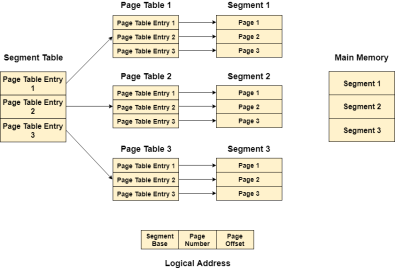
Fig 17 – Logical address
Translation of logical address to physical address
The CPU generates a logical address which is divided into two parts: Segment Number and Segment Offset. The Segment Offset must be less than the segment limit. Offset is further divided into Page number and Page Offset. To map the exact page number in the page table, the page number is added into the page table base.
The actual frame number with the page offset is mapped to the main memory to get the desired word in the page of the certain segment of the process.
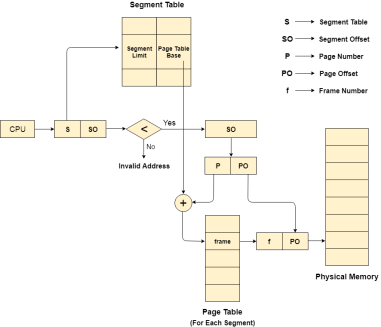
Fig 18 – Page table
Advantages of Segmented Paging
Disadvantages of Segmented Paging
Key takeaway-
Segmentation:
In Operating Systems, Segmentation is a memory management technique in which, the memory is divided into the variable size parts. Each part is known as segment which can be allocated to a process.
The details about each segment are stored in a table called as segment table. Segment table is stored in one (or many) of the segments.
Segment table contains mainly two information about segment:
Virtual Memory is a storage scheme that provides user an illusion of having a very big main memory. This is done by treating a part of secondary memory as the main memory.
In this scheme, User can load the bigger size processes than the available main memory by having the illusion that the memory is available to load the process.
Instead of loading one big process in the main memory, the Operating System loads the different parts of more than one process in the main memory.
By doing this, the degree of multiprogramming will be increased and therefore, the CPU utilization will also be increased.
How Virtual Memory Works?
In modern word, virtual memory has become quite common these days. In this scheme, whenever some pages needs to be loaded in the main memory for the execution and the memory is not available for those many pages, then in that case, instead of stopping the pages from entering in the main memory, the OS search for the RAM area that are least used in the recent times or that are not referenced and copy that into the secondary memory to make the space for the new pages in the main memory.
Since all this procedure happens automatically, therefore it makes the computer feel like it is having the unlimited RAM.
Demand Paging:
Demand Paging is a popular method of virtual memory management. In demand paging, the pages of a process which are least used, get stored in the secondary memory.
A page is copied to the main memory when its demand is made or page fault occurs. There are various page replacement algorithms which are used to determine the pages which will be replaced. We will discuss each one of them later in detail.
Snapshot of a virtual memory management system:
Let us assume 2 processes, P1 and P2, contains 4 pages each. Each page size is 1 KB. The main memory contains 8 frame of 1 KB each. The OS resides in the first two partitions. In the third partition, 1st page of P1 is stored and the other frames are also shown as filled with the different pages of processes in the main memory.
The page tables of both the pages are 1 KB size each and therefore they can be fit in one frame each. The page tables of both the processes contain various information that is also shown in the image.
The CPU contains a register which contains the base address of page table that is 5 in the case of P1 and 7 in the case of P2. This page table base address will be added to the page number of the Logical address when it comes to accessing the actual corresponding entry.
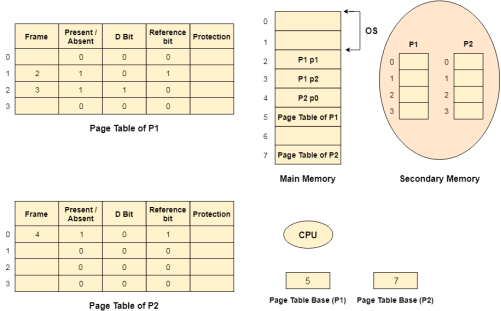
Fig 19 – Virtual memory
Advantages of Virtual Memory:
Disadvantages of Virtual Memory:
Key takeaway-
Virtual Memory is a storage scheme that provides user an illusion of having a very big main memory. This is done by treating a part of secondary memory as the main memory.
In this scheme, User can load the bigger size processes than the available main memory by having the illusion that the memory is available to load the process.
Instead of loading one big process in the main memory, the Operating System loads the different parts of more than one process in the main memory.
By doing this, the degree of multiprogramming will be increased and therefore, the CPU utilization will also be increased.
Demand Paging:
According to the concept of Virtual Memory, in order to execute some process, only a part of the process needs to be present in the main memory which means that only a few pages will only be present in the main memory at any time.
However, deciding, which pages need to be kept in the main memory and which need to be kept in the secondary memory, is going to be difficult because we cannot say in advance that a process will require a particular page at particular time.
Therefore, to overcome this problem, there is a concept called Demand Paging is introduced. It suggests keeping all pages of the frames in the secondary memory until they are required. In other words, it says that do not load any page in the main memory until it is required.
Whenever any page is referred for the first time in the main memory, then that page will be found in the secondary memory.
After that, it may or may not be present in the main memory depending upon the page replacement algorithm which will be covered later in this tutorial.
What is a Page Fault?
If the referred page is not present in the main memory then there will be a miss and the concept is called Page miss or page fault.
The CPU has to access the missed page from the secondary memory. If the number of page fault is very high then the effective access time of the system will become very high.
What is Thrashing?
If the number of page faults is equal to the number of referred pages or the number of page faults are so high so that the CPU remains busy in just reading the pages from the secondary memory then the effective access time will be the time taken by the CPU to read one word from the secondary memory and it will be so high. The concept is called thrashing.
If the page fault rate is PF %, the time taken in getting a page from the secondary memory and again restarting is S (service time) and the memory access time is ma then the effective access time can be given as;
Page Replacement Algorithms
The page replacement algorithm decides which memory page is to be replaced. The process of replacement is sometimes called swap out or write to disk. Page replacement is done when the requested page is not found in the main memory (page fault).

There are two main aspects of virtual memory, Frame allocation and Page Replacement. It is very important to have the optimal frame allocation and page replacement algorithm. Frame allocation is all about how many frames are to be allocated to the process while the page replacement is all about determining the page number which needs to be replaced in order to make space for the requested page.
What If the algorithm is not optimal?
1. if the number of frames which are allocated to a process is not sufficient or accurate then there can be a problem of thrashing. Due to the lack of frames, most of the pages will be residing in the main memory and therefore more page faults will occur.
However, if OS allocates more frames to the process then there can be internal fragmentation.
2. If the page replacement algorithm is not optimal then there will also be the problem of thrashing. If the number of pages that are replaced by the requested pages will be referred in the near future then there will be more number of swap-in and swap-out and therefore the OS has to perform more replacements then usual which causes performance deficiency.
Therefore, the task of an optimal page replacement algorithm is to choose the page which can limit the thrashing.
Types of Page Replacement Algorithms
There are various page replacement algorithms. Each algorithm has a different method by which the pages can be replaced.
Key takeaway-
According to the concept of Virtual Memory, in order to execute some process, only a part of the process needs to be present in the main memory which means that only a few pages will only be present in the main memory at any time.
However, deciding, which pages need to be kept in the main memory and which need to be kept in the secondary memory, is going to be difficult because we cannot say in advance that a process will require a particular page at particular time.
Therefore, to overcome this problem, there is a concept called Demand Paging is introduced. It suggests keeping all pages of the frames in the secondary memory until they are required. In other words, it says that do not load any page in the main memory until it is required.
Whenever any page is referred for the first time in the main memory, then that page will be found in the secondary memory.
Memory Management is the process of controlling and coordinating computer memory, assigning portions known as blocks to various running programs to optimize the overall performance of the system.
It is the most important function of an operating system that manages primary memory. It helps processes to move back and forward between the main memory and execution disk. It helps OS to keep track of every memory location, irrespective of whether it is allocated to some process or it remains free.
Why Use Memory Management?
Here, are reasons for using memory management:
a) It allows you to check how much memory needs to be allocated to processes that decide which processor should get memory at what time.
b) Tracks whenever inventory gets freed or unallocated. According to it will update the status.
c) It allocates the space to application routines.
d) It also make sure that these applications do not interfere with each other.
e) Helps protect different processes from each other .
f) It places the programs in memory so that memory is utilized to its full extent.
Memory Management Techniques:
Here, are some most crucial memory management techniques:
Single Contiguous Allocation:
It is the easiest memory management technique. In this method, all types of computer's memory except a small portion which is reserved for the OS is available for one application. For example, MS-DOS operating system allocates memory in this way. An embedded system also runs on a single application.
Partitioned Allocation:
It divides primary memory into various memory partitions, which is mostly contiguous areas of memory. Every partition stores all the information for a specific task or job. This method consists of allotting a partition to a job when it starts & unallocate when it ends.
Paged Memory Management:
This method divides the computer's main memory into fixed-size units known as page frames. This hardware memory management unit maps pages into frames which should be allocated on a page basis.
Segmented Memory Management:
Segmented memory is the only memory management method that does not provide the user's program with a linear and contiguous address space.
Segments need hardware support in the form of a segment table. It contains the physical address of the section in memory, size, and other data like access protection bits and status.
What is Swapping?
Swapping is a method in which the process should be swapped temporarily from the main memory to the backing store. It will be later brought back into the memory for continue execution.
Backing store is a hard disk or some other secondary storage device that should be big enough inorder to accommodate copies of all memory images for all users. It is also capable of offering direct access to these memory images.
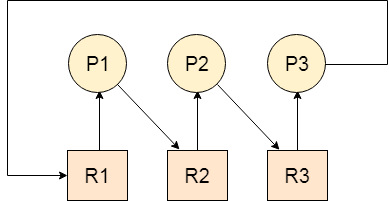
Fig 20 - Swapping
Benefits of Swapping-
Here, are major benefits/pros of swapping:
a) It offers a higher degree of multiprogramming.
b) Allows dynamic relocation. For example, if address binding at execution time is being used, then processes can be swap in different locations. Else in case of compile and load time bindings, processes should be moved to the same location.
c) It helps to get better utilization of memory.
d) Minimum wastage of CPU time on completion so it can easily be applied to a priority-based scheduling method to improve its performance.
What is Memory allocation?
Memory allocation is a process by which computer programs are assigned memory or space.
Here, main memory is divided into two types of partitions
Partition Allocation
Memory is divided into different blocks or partitions. Each process is allocated according to the requirement. Partition allocation is an ideal method to avoid internal fragmentation.
Below are the various partition allocation schemes :
What is Paging?
Paging is a storage mechanism that allows OS to retrieve processes from the secondary storage into the main memory in the form of pages. In the Paging method, the main memory is divided into small fixed-size blocks of physical memory, which is called frames. The size of a frame should be kept the same as that of a page to have maximum utilization of the main memory and to avoid external fragmentation. Paging is used for faster access to data, and it is a logical concept.
What is Fragmentation?
Processes are stored and removed from memory, which creates free memory space, which are too small to use by other processes.
After sometimes, that processes not able to allocate to memory blocks because its small size and memory blocks always remain unused is called fragmentation. This type of problem happens during a dynamic memory allocation system when free blocks are quite small, so it is not able to fulfill any request.
Two types of Fragmentation methods are:
What is Segmentation?
Segmentation method works almost similarly to paging. The only difference between the two is that segments are of variable-length, whereas, in the paging method, pages are always of fixed size.
A program segment includes the program's main function, data structures, utility functions, etc. The OS maintains a segment map table for all the processes. It also includes a list of free memory blocks along with its size, segment numbers, and its memory locations in the main memory or virtual memory.
What is Dynamic Loading?
Dynamic loading is a routine of a program which is not loaded until the program calls it. All routines should be contained on disk in a relocatable load format. The main program will be loaded into memory and will be executed. Dynamic loading also provides better memory space utilization.
What is Dynamic Linking?
Linking is a method that helps OS to collect and merge various modules of code and data into a single executable file. The file can be loaded into memory and executed. OS can link system-level libraries into a program that combines the libraries at load time. In Dynamic linking method, libraries are linked at execution time, so program code size can remain small.
Difference Between Static and Dynamic Loading
Static Loading | Dynamic Loading |
Static loading is used when you want to load your program statically. Then at the time of compilation, the entire program will be linked and compiled without need of any external module or program dependency. | In a Dynamically loaded program, references will be provided and the loading will be done at the time of execution. |
At loading time, the entire program is loaded into memory and starts its execution. | Routines of the library are loaded into memory only when they are required in the program. |
Difference Between Static and Dynamic Linking
Here, are main difference between Static vs. Dynamic Linking:
Static Linking | Dynamic Linking |
Static linking is used to combine all other modules, which are required by a program into a single executable code. This helps OS prevent any runtime dependency. | When dynamic linking is used, it does not need to link the actual module or library with the program. Instead of it use a reference to the dynamic module provided at the time of compilation and linking. |
Summary:
a) Memory management is the process of controlling and coordinating computer memory, assigning portions called blocks to various running programs to optimize the overall performance of the system.
b) It allows you to check how much memory needs to be allocated to processes that decide which processor should get memory at what time.
c) In Single Contiguous Allocation, all types of computer's memory except a small portion which is reserved for the OS is available for one application
d) Partitioned Allocation method divides primary memory into various memory partitions, which is mostly contiguous areas of memory
e) Paged Memory Management method divides the computer's main memory into fixed-size units known as page frames
f) Segmented memory is the only memory management method that does not provide the user's program with a linear and contiguous address space.
g) Swapping is a method in which the process should be swapped temporarily from the main memory to the backing store. It will be later brought back into the memory for continue execution.
h) Memory allocation is a process by which computer programs are assigned memory or space.
i) Paging is a storage mechanism that allows OS to retrieve processes from the secondary storage into the main memory in the form of pages.
j) Fragmentation refers to the condition of a disk in which files are divided into pieces scattered around the disk.
k) Segmentation method works almost similarly to paging. The only difference between the two is that segments are of variable-length, whereas, in the paging method, pages are always of fixed size.
l) Dynamic loading is a routine of a program which is not loaded until the program calls it.
m) Linking is a method that helps OS to collect and merge various modules of code and data into a single executable file.
Key takeaway
Memory Management is the process of controlling and coordinating computer memory, assigning portions known as blocks to various running programs to optimize the overall performance of the system.
It is the most important function of an operating system that manages primary memory. It helps processes to move back and forward between the main memory and execution disk. It helps OS to keep track of every memory location, irrespective of whether it is allocated to some process or it remains free.
Text Books:
1. Operating System Concepts - Abraham Silberschatz, Peter B. Galvin & Grege Gagne (Wiley)
2. Operating Systems - A Concept Based approach - Dhananjay M Dhamdhere (TMGH).
Reference Books:
1. Unix Concepts and Applications – Sumtabha Das (TMGH).
2) Operating System : Concepts and Design - Milan Milenkovic ( TMGH)
3) Operating System with case studies in Unix, Netware and Windows NT - Achyut S. Godbole (TMGH).